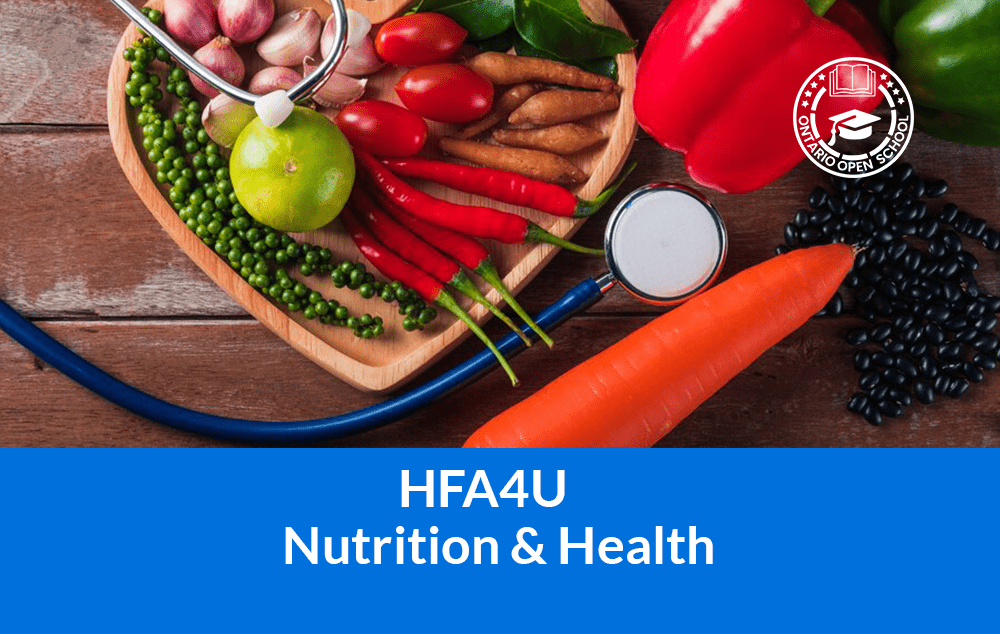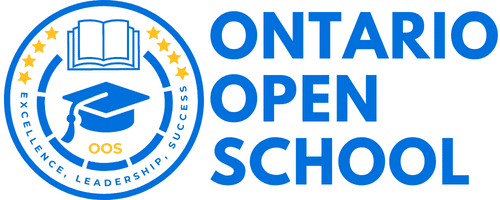- info@ontarioopenschool.com
- 647-494-4499
-
Unit 100 - 29 Gervais Drive, North York, ON.
M3C 1Y9
Copyright 2024 Ontario Open School Inc. All Rights Reserved.
This course examines the relationships between food, energy balance, and nutritional status; the nutritional needs of individuals at different stages of life; and the role of nutrition in health and disease. Students will evaluate nutrition-related trends and will determine how food choices can promote food security and environmental responsibility. Students will learn about healthy eating, expand their repertoire of food-preparation techniques, and develop their social science research skills by investigating issues related to nutrition and health.
Unit Order | Unit Name | Suggested Time |
|---|---|---|
| Unit 1 | B: Nutrition and Health The focus of this unit is nutrition and health. First, students will explore different macronutrients including carbohydrates, fats, proteins, fibre, sugar, water as well as micronutrients such as vitamins and minerals. For each nutrient, students will learn what the nutrient is, food products that contain this nutrient, the process of digestion and absorption and the role of the nutrient in the body. They will examine their own eating and drinking habits by completing a three-day diet log and analysing the results. Second, they will explore the concept of energy balance, including ideal caloric consumption and the role of exercise in a healthy lifestyle. Finally, the relationship between nutrition and disease is analyzed including the determinants of health, causes of disease and how nutritional needs change during times of illness. This unit will cover the psychological, emotional, cultural, and economic factors that influence our food choices. Students will also explore what may influence a person to follow a vegetarian or alternative diet, including media influence. In the second part of this unit, students will critique Canada’s Food Guide, looking at when it was first introduced, the purpose of following a food guide, adjustments that have been made to the guide, and other dietary guides that are followed in addition to Canada’s Food Guide. Students will also learn about dietary reference intakes and the components of a nutritious diet. In the third and final module of this unit, they will learn about nutrition through the lifespan and the specific dietary needs associated with infants, toddlers, children, adolescents, adults, and older adults. | 27 hours |
| Unit 2 | C: Eating Patterns and Trends In this unit, students examine various trends and patterns in food and nutrition. They will learn about some of the new food products on supermarket shelves and emerging eating patterns or diet trends. Increasingly, food products and trends are heavily marketed for their health benefits, and they will research whether these benefits are real or perceived and evaluate the potential benefits or dangers of eating a certain food product or following a specific diet. In the second half of the unit, students focus on preparing and cooking food at home. First and foremost, students will learn about the importance of kitchen and food safety including proper techniques for using kitchen tools and appliances but also safe methods for handling and storing food to prevent foodborne illnesses. They will have the opportunity to put their knowledge of kitchen and food safety to the test in the final module of this unit that focuses on preparing food. They will learn about the steps to follow when cooking food, how to modify recipes and selecting appropriate cooking tools and cooking methods. At the end of this unit, students will prepare their favorite meal showcasing safe and proper food preparation techniques. | 27 hours |
| Unit 3 | D: Local and Global Issues In this unit, students will explore the role that economic, political, and environmental factors have on the production of food. They will look closely at Canadian agriculture including various agricultural methods, meat and poultry farming, the dairy industry, and horticulture. World hunger and food insecurity will be the focus in the second half of the unit and students will explore the reasons why food security issues arise, the nutrient deficiencies that result from malnourishment, and what is or can be done to combat hunger. Finally, they will delve into the preparation, cooking, serving, and eating techniques of culture specific foods. On the international scale, students will assess the various political and economic causes of world hunger. The various factors that affect the production and supply of food are explored in the second module, including an analysis of the global water supply, agricultural methods and the increasing use of biotechnologies in food production. Finally, the environmental impact of food production will be considered. Environmental protection laws and policies exist but are they adequate for preventing environmental degradation? An important theme throughout the unit is the power of consumer choices and steps that can be taken to reduce food insecurity at the local and global level. | 26 hours |
| Unit 4 | E.Food Preparation Skills In the final unit of the course, students will learn research techniques that will be valuable and useful in their university career including, choosing a research topic, conducting a literature review, conducting research and analyzing findings, drawing conclusions, and compiling research in a written report and oral presentation. As a final culminating assignment, students will complete a Major Research Paper. This project is worth 30% of the final grade. | 22 hours |
| Final Evaluation 30% | Final Project Final exam | 6 hours 2 hours |
| Total | 110 hours |
A wide variety of instructional strategies are used to provide learning opportunities to accommodate a variety of learning styles, interests and ability levels. These strategies include, but are not limited to:
Guided Exploration
Visualization
Workbook
Case Study
Independent Study
Learning Journal/ Log
Portfolio
Inquiry and Research Process
Computer Assisted Instruction
Purpose
The primary purpose of assessment is to improve student learning. Assessment relates directly to the expectations for the course.
A variety of assessments for and as learning are conducted on a regular basis to allow ample opportunities for students to improve and ultimately demonstrate their full range of learning and for the teacher to gather information to provide feedback. Assessment tasks relate to the success criteria set out in lesson plans. Success criteria allow students to see what quality looks like.
Evaluation is the process of judging the quality of student work in relation to the achievement chart categories and criteria and assigning a percentage grade to represent that quality. Evaluation is based on gathering evidence of student achievement through:
Assessment for Learning – we provide feedback and coaching. Assessment FOR Learning is the process of seeking and interpreting evidence for the use of learners and their teachers to decide where the learners are in their learning, where they need to go, and how best to go there.
Assessment as Learning – we help students monitor progress, set goals, reflect on their learning
Assessment AS Learning is the process of the explicit fostering of students’ capacity over time to be their own best assessors, but teachers need to start by presenting and modeling external, structured opportunities for students to assess themselves.
Assessment of Learning – we use assessments to provide evaluative statements about student achievement. Assessment OF Learning is the assessment that becomes public and results in statements of symbols
(marks/grades/levels of achievement) about how well students are learning. It often contributes to pivotal decisions that will affect students’ future.
ASSESSMENT TOOLS
| Assessment and evaluation in this course will be continuous throughout the term and will include a variety of methods. | ||
| Assessment As Learning | Assessment For Learning | Assessment Of Learning |
|
Student Product: Learning Logs KWL Chart Self-Assessment (Reflections)
|
Student Product:
Assigned Questions / Homework Reflective Journal Diagnostic Quiz / Worksheet |
Student Product: Unit Culminating Activities Unit Tests Independent Study Project Final Exam Course Reflection Journal |
|
Observation: Reflective Discussion |
Observation:
Individual Performance Task (Demonstration) |
Observation: Individual Presentations Performance Task (Demonstration)
|
|
Conversation: Discussion
|
Conversation:
Discussion
|
Conversation: Student Teacher Conferencing |
Resources
Grading
Weighting of categories
| Knowledge/Understanding | Thinking/Inquiry | Communication | Application |
| 25 % | 25% | 25 % | 25% |

Course Grade | Grade 12 |
|---|---|
Course Code | HFA4U |
Course Category | Social Sciences and Humanities |
Course Type | University Preparation |
Course Delivery | Online |
Course Duration | 8hrs |
Course Credit | 0 |
Copyright 2024 Ontario Open School Inc. All Rights Reserved.
